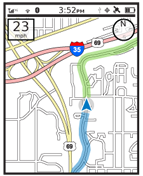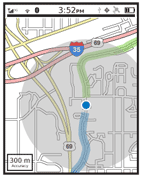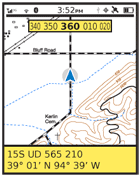Problem
Availability of location based service, and the actual location of the handset must be easily and accurately communicated.

Solution
Mobile devices have numerous methods of retrieving location information. These are listed in, approximately, less to more precision, but are not necessarily better or worse otherwise.
Cell -- The location of the BTS (cell tower) is well-known, and its ID is attached to the call record. The actual precision varies, but a good rule of thumb is to assume the device is in a circle 3000 m across.
Does that mean that the device's range is 1,500 m from the Cell's location (radius)?
Sector -- The sector (antenna pointing a specific direction) on the cell can be detected by the operator (i.e. not while roaming). This provides a much smaller area, around 1200 m across. Yes, sectors are not circles, but it's dificult to communicate shape and orientation, so this is close enough.
Triangulation -- Triangulation is the practice of determining the location of a point by measuring the angle and/or distance from several known locations. More points give more precision. Methods of triangulating with radio get really complex and vary by network type and equipment available. Precision varies, and is generally included with the result by the network service calculating the location. 12 yard precision is possible, but 50 m is more likely.
GPS Telemetry -- The ubiquitous satellite-based network. Portable, hand-held receivers like those in mobile handsets can generally be assumed to give precision of 20-50 ft, though antenna and signal processing improves constantly and precision can be in single digit feet. Others, such as Galileo, GLONASS and COMPASS may also be included in general mobile devices, and will operate in similar ways. In theory, eventually, using multiple unrelated systems will give better accuracy yet, and give better coverage when in touchy situations like in dense cities.
WAAS -- WAAS is a satellite based augmentation system based in North America (others exist in the rest of the world, but are less well-established) that sends additional signals via another set of satellites to allow GPS receivers to adjust for those inaccuracies. I know of no mobile phones that have a built-in WAAS receiver, but it's a location technology that does exist, and is employed on cell towers using AGPS.
Not clear what you mean by "inaccuracies"?
AGPS -- Assisted GPS sends part of the GPS signal to the device over the mobile network connection in order to provide additional precision, and speed the startup time of the GPS to as good as a few seconds. AGPS is not generally selectable as a separate service; when the user chooses to turn on or off "GPS," and has a network connection (and an AGPS compliant phone, etc.) they get the advantages of AGPS.
WLANs & PANs -- Local networks like WiFi and Bluetooth are localized radio technologies, and can add another layer of location, so could increase precision. They can also be used instead of other technologies when there is no GPS signal, or a bad mobile signal so triangulation cannot be used.
Both of these currently use the "cell" (or network identifier) and triangulation methods described above.
They are both relatively more rare, and often are supported by third party software or individual services (which may have specific capabilities), and are not universally implemented on the handset. There are no reliable, independently verified numbers on the real-world precision, but tests of WiFi triangulation alone have gone down to inches. On the other hand, poor network identification has led to placing users on the wrong continent.
Ask -- People often know where they are. If you cannot get any location, or there's a reason they might want to over-ride it (even as simple as the data is bad) let them enter a location. If you do this, allow lots of methods. Only accepting ZIP or postal code is not useful for e.g. travellers, who do not generally know the ZIP where they are.
Each of these must be understood, be able to be used (as long as the hardware is available) by the system and by each application, and communicate the correct degree of precision and accuracy.
An understanding of the difference between precision and accuracy is also crucial. In brief: precision is the number of decimal places you measure something to; accuracy is how correct it is. The less accurate you think your measurement is, the less precise you should report it.
Privacy and security concerns are beyond the scope of this book, but must be considered when designing location based services. In many countries, there are legislative or regulatory restrictions on enabling and use of location services, so notification of background tracking is a legal requirement, not just best practice.
Location is not the same as Orientation or other types of position information. When these must be communicated -- as for augmented reality -- they are generally deeply integral to the visualization and interactive design of the application. No distinct patterns yet exist for these behaviors, but best practices from aviation may serve to guide designs.
Variations
Location service is often used as a background service, or promote smarter ambient computing,. When directly referred to, it may only be momentarily switched to while other tasks occupy the remaining time. Therefore, both explicit and background indicators cases may be present not just in the same system, but at the same time.
Explicit - Location services are currently mostly used for explicit location applications, such as mapping, directions, local information and augmented reality. These explicit representations of location are discussed in detail below.
Background - Location services can also be used as a trigger to initiate notifications, or change behaviors of the device. Geofencing, location-driven advertising and location based profile changes (e.g. silent when in a meeting room) have all been trialled, but are not widely adopted.
Settings, including installation of applications using location services, must also take into account these principles, especially those of privacy and awareness.
Though this pattern discusses such behaviors and features on a mobile device, they may also be used for remote devices in much the same manner. "Child trackers" and similar functions may be used from another mobile device or from desktop computers to track a remote mobile device. In this case, both the viewing terminal and the mobile device must both consider the display and behavior attributes of this pattern.

Interaction Details
Indicators of state are generally only present in the Annunciator Row and cannot be interacted with. A system setting should be made available to control the use of GPS, WiFi and other controls, as well as to set privacy controls for sharing and how much automatic (vs. manual) control is allowed over these systems.
An easy method must be provided to access this control, without drilling into multiple sub-menus. Whenever possible, add this control shortcut to any application that uses location services. The control may also be added as an interactive Icon on the Idle Screen for access from any application, or so the user may manually enable the service before it is needed.
Whenever possible, applications or services which are best with location should automatically enable the required hardware. OS level restrictions or user settings may interfere with this behavior, and require user intervention each time. If so, an interstitial Pop-Up is often the best way to request this.
When the Pop-Up itself is restricted from offering a function to enable the GPS (or other hardware), use it sparingly, as a reminder to the user instead, and provide a link to the appropriate settings panel. When settings are changed, always return the user to the originally-requested application.
Only use the precision required for the task at hand. Weather, for example, rarely requires more than city-level precision. The GPS is not required for basic conditions and forecast information.
On the other hand, always present the most relevant details for each view. If the user chooses to view a local radar map, they should not be required to know their location but should be presented it systematically. The weather application may have to turn on and off various location services as the application is used, and should not enable all services when it is opened, or get by with only the minimal set and present less than optimal information.
![]()
Presentation Details
When location service is enabled, this should be shown in the Annunciator Row, generally as an icon. The location icon (crosshair) has come to mean GPS is enabled, so there may be challenges in communicating other types of location services. GPS can use other types of icons, such as a satellite dish. GPS requires a short time to find position, and can loose position due to interference, clutter or other conditions, and must display the current status. Generally, animating the satellite dish (implying "scanning for service") works well.
Avoid duplicating indicators. If in the Annunciator Row, there is generally no need to also include such indicators within an application. This is another good reason to preserve Annunciator Row display, instead of loading applications full-screen.
For explicit graphic display of location, such as on a map, a cursor will be used to denote the current position. Note that this is actually the centroid of the CEP or circular error of probability. A probability threshold is programatically established; based on the technology used to determine location, the device is almost certainly located within this circle. (Note, it is impossible to absolutely determine location, hence the "probability" prhasing, but this is not terribly important for general discussions).
This CEP circle should be displayed, with the cursor at the center, as a visual method of communicating the precision of the location technology. Unless additional precision is needed but is currently unavailable, the default view should hide the CEP circle from the user. For a weather map, for example, the default zoom level should be large enough that a 100 m CEP is smaller than the cursor, so disappears under it. Good selection of map zoom level also helps communicate the degree of precision available.

When the display is zoomed such that the CEP circle is at least 10 times the size of the cursor, or the edge is partly or entirely outside the viewport, an explicit display of precision (discussed below) should be printed adjacent to the cursor.
An even greater pitfall in the display of precision information is with printed location, especially in coordinate systems. Whenever possible, use standard, well-understood nomenclature. Avoid printing the location when not useful; lat/long is difficult to interpret and very few general users will understand it.
Precision also must be accounted for. For this example, the MGRS coordinate system will be employed as it is based on simple measurements from a regional baseline. This is unlikely to be employed in general consumer applications, however. A complete location to 1 meter precision is listed as:
15S UD 12345 67890
However, most location technologies, in most instances, cannot give such precision. Digits should be removed until only the correct level of precision is shown. For example, if using cell sector, with precision in the 100 m range, only display
15S UD 123 678
The last digit will always be of less precision than the others, and even when displayed digitally can be used like that on a dial or scale. Simply restrict the display to only the 5 or 0 digits.
Precision should be explicitly displayed when coordinates are printed. Use the existing settings for units of measure, but scale them appropriately. In the following examples, the user has set their navigation tool to use miles.
"Accuracy 19 ft" - Correct. Appropriate scale (vs. yards or miles) for the size, and in the same system.
"Accuracy 6 m" - Incorrect. In the wrong system of measure.
"Accuracy 0.004 mi" - Incorrect. Too large a measure, so many decimals, and not easily understood.
Note that the term "precision" is not well understood, so is often replaced with "accuracy" in general communications, as in the examples above, although it is not strictly true.
Addresses, likewise, should only be displayed when that level of precision is available. Otherwise use existing best practices for general location:
- 5600 Russell Ave, Mission, Kansas 66202
56th Street & Russell Ave, Mission, Kansas 66202 - Street or Intersection
West Crossland, Mission, Kansas 66202 - Neighborhood
Mission, Kansas 66202 - City
10 miles west of downtown Kansas City, MO - Relative Location
Near Kansas City, MO - Area
Only display the larger scale information such as state and country when needed. When moving between two areas only a few miles apart, the default location display should probably just be the street address portion. The same filtering logic should be used for coordinate systems, when applicable. While Lat/Long is a global system, UTM and MGRS are divided into regions; the "15S UD" portion in the example above can be made much less prominent, as most precision navigation is not also global navigation, so it will not be used as much as the remainder of the displayed coordinates.
Direction of travel should only be displayed when available, and should only display to the degree known. Generally, the cursor will be a pointer to assist with this. For free standing displays, when users will understand, display bearing in degrees, and by named directions (north-east) but degrade to cardinal directions as the system's understanding becomes more poor.
Cardinal directions (e.g. "North") can imply precision if simply printed on the screen; use graphic displays (either dials or circular Tapes) to communicate the degree of precision available, make small changes in bearing angle visible to the user and make the display more glanceable.
When direction of travel cannot be determined (there is no compass and the device is not moving), display no direction of travel indicator, or an icon indicating it is unknown. The cursor may change to circle, or otherwise become blunted to reduce or remove the implication that direction is known. Do not display the last direction, as this is likely to be spurious data arising from loss of signal or stopping.
When direction of travel is available, orient the map so direction of travel is forward, or up. If there is a specific reason not to do this by default, provide a function so the user can switch to this mode.
Antipatterns
Never equate "location" with "GPS," especially to the degree that a location aware service or application may only launch when the GPS is enabled.
Never display or imply precision that is not available. Avoid the use of crosshairs and other implied attributes, even if a CEP circle is displayed as well.
